|
Behavioral problems can be traced to saddle fitting issues.
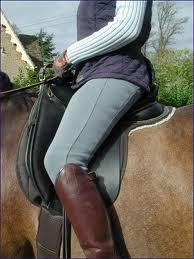
A well fitting saddle will distribute the rider's weight over as large an area as possible while keeping the withers, spine, shoulders, and loins free from pressure. The saddle can create many problems for a horse if it bridges, is too long, not wide enough, or any number of other fitting issues. In addition many behavioral problems can be traced to saddle fitting issues. A saddle is one of the first pieces of equipment most people buy after they acquire a horse. As a major investment, selecting and purchasing a functional saddle requires much deliberation and knowledge. The life span of most saddles is several times that of a horse, so take great care in selecting a saddle.
10 Steps to Saddle Fitting
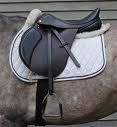
1. Position of the saddle: Put the saddle upon the horses wither and slide back to where it sits "at home base". This is the correct position of the saddle.
2. Check the tree points: The tree points should be at approximately a 10 degree angle along the resting surface of the horse. The saddle should be approx. 2" from the scapula.
3. Levelness of seat: When the saddle is sitting flat on the horse's back, the deepest part of the seat should appear to be parallel to the ground. Visualize a straight line parallel to the ground and look at the deepest part of the seat. This area should be level in order to put the rider squarely on their seat bones and in balance.
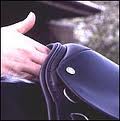
4. Adequate pommel clearance: The clearance needs to be 3 fingers between the pommel and wither. In some cases, the clearance may be lower and still be adequate. If it is more than 3" it is indicating too narrow of a tree.
6. Pommel to cantle connection: With the saddle in the correct position, the cantle should be significantly higher than the pommel when it is viewed from the side. Do a pressure test, the saddle should not rock if you alternately put pressure on the pommel and cantle.
7. Seat length: The saddle should never go behind the 18th thoracic vertebra, which is the vertebra corresponding with the last rib. Behind this vertebra are the lumbar vertebrae, which is the weakest, non-weight bearing area of the back.
8. Lateral stability: Gently rock the cantle side to side to make certian the saddle does not slide lateraly. The saddle should remain stable and not shift excessively from side to side or from front to back. Keep in mind that such shifting may be a function of your horse's symmetry and not the saddle. A qualified saddle fitter should be able to make suggestions to minimize or eliminate the problem.
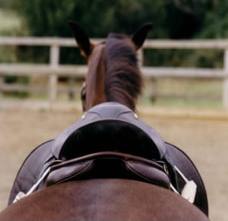
9. The gullet or channel: There should also be adequate clearance over the spine and connective tissue throughout the channel of the saddle. A channel that is too narrow will impede the horse’s movement dramatically and may even cause the spine to be observably sore. Feel the width of the spine and connective tissue with your fingers and estimate its width. The channel of the saddle should completely clear this width, resting on the long back muscle of the back called the longissimus dorsi.
10. The horses reactions: Keep in mind if your horse is pinning his ears, trying to kick or bite at you or the saddle, he is trying to say that he’s uncomfortable. This applies to all of the steps of saddle fitting. The horse is the most honest indicator we have when fitting a saddle so pay attention to it and note any changes. Once you have determined that a saddle appears to fit the horse, you should then tack the horse up and have the rider mount up. Have them walk, trot on both diagonals and canter on both leads. Once again, watch for any signs of horse discomfort such as ears pinning, bobbing head, short strides or unusually high head carriage.
The horse generally tells the story the best by moving forward smoothly in a relaxed and comfortable manner. A properly fitting saddle is an essential part of having a good ride. An ill fitting saddle may cause a lack of performance or even physical injury to the horse.
Source - A.F. Brown, saddle fitting
|
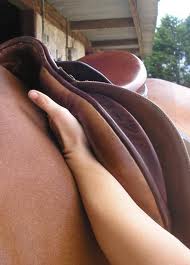 5. Panel pressure: "Bridging" is the result of a panel that is not contoured to fit the shape of the horse's back. Run your hand under the flap, back towards the stirrup bars. There should be room to slide your hand in. If it is too tight you will feel pressure. Run your flat hand under the middle of the panels, if there is enough room to put your whole hand in your saddle is 'bridging.' If it's very tight and allowing your saddle to 'rock' when you put alternating pressure at the pommel and the cantle it means that your saddle is overstuffed.
5. Panel pressure: "Bridging" is the result of a panel that is not contoured to fit the shape of the horse's back. Run your hand under the flap, back towards the stirrup bars. There should be room to slide your hand in. If it is too tight you will feel pressure. Run your flat hand under the middle of the panels, if there is enough room to put your whole hand in your saddle is 'bridging.' If it's very tight and allowing your saddle to 'rock' when you put alternating pressure at the pommel and the cantle it means that your saddle is overstuffed.
